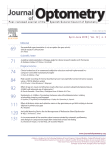Keratometry in children: Comparison between auto-refractokeratometer, rotating scheimpflug imaging, and biograph
Authors
Affiliations
1Noor Research Center for Ophthalmic Epidemiology, Noor Eye Hospital, Tehran, Iran.
2Department of Rehabilitation Science, School of Allied Medical Sciences, Mazandaran University of Medical Sciences, Sari, Iran.
3Department of Medical Surgical Nursing, School of Nursing and Midwifery, Shahid Beheshti University of Medical Sciences, Tehran, Iran.
4Refractive Errors Research Center, Mashhad University of Medical Sciences, Mashhad, Iran.
5Ophthalmic Epidemiology Research Center, Shahroud University of Medical Sciences, Shahroud, Iran. Electronic address: emamian@shmu.ac.ir.
6Department of Epidemiology and Biostatistics, School of Public Health, Tehran University of Medical Sciences, Tehran, Iran.
Abstract
Purpose: To determine the agreement and validity of keratometric measurements in children with the Nidek ARK-510A auto-refractokeratometer compared to rotating Scheimpflug imaging with Pentacam and biograph with Lenstar LS 900.
Methods: This study was conducted on 5620 schoolchildren aged 6-12 years in Shahroud, Iran. Minimum and maximum keratometry values and corneal astigmatism magnitude were compared by calculation of Paired difference, interclass correlation coefficient, and 95% limits of agreement (LoA) between devices.
Results: After applying the exclusion criteria, 4215 right eyes were enrolled into the study. Mean minimum keratometry with Nidek ARK-510A, Pentacam, and Lenstar was 43.13±1.51, 43.14±1.48, and 42.87±1.46 diopters (D), respectively, and mean maximum keratometry was 43.97±1.59, 44.00±1.56, and 43.75±1.54D, respectively. Nidek ARK-510A overestimated minimum and maximum keratometry by 0.25±0.37 and 0.22±0.41, respectively, compared to Penatcam. The LoA between Nidek ARK-510A and Pentacam for minimum and maximum keratometry measurements were -0.98 to 0.47D and -1.02 to 0.57D, respectively. The LoA between Nidek ARK-510A and Lenstar for minimum and maximum keratometry measurements were -0.70 to 0.72D and -0.79 to 0.85D, respectively. The agreement between devices was best in emmetropes, worst in hyperopes. For astigmatic vector components, the agreements between devices were poor but best agreement was between Nidek ARK-510A and Pentacam.
Conclusions: Keratometry measurement with Nidek ARK-510A was not significantly different from Pentacam and Lenstar, and this device can be used in screening programs in emmetropes.
Keywords: Auto-refractokeratometer; Autorefractoqueratómetro; Biograph; Biómetro; Children; Keratometry; Niños; Pentacam; Queratometría.

